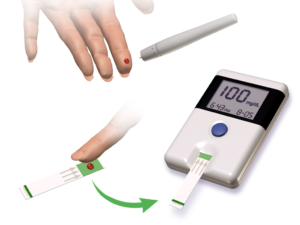Dylan Covey, a 26-year-old pitcher for the Chicago White Sox, has type 1 diabetes. I have type 1 diabetes, too – that’s the disease that caused my blindness.

Blood glucose monitoring is undoubtedly a part of Covey’s routine now.
Covey was diagnosed during a standard physical in his freshman year of college, when the Milwaukee Brewers drafted him 14th overall in the first round of the 2010 MLB draft. What a blow that must have been. The diagnosis came just days before his signing, and he and his parents decided it’d be best for him to forego the Brewers’ offer and take advantage of his athletic scholarship at University of San Diego instead. “For whatever reason I wasn’t meant to sign with the Brewers,” Covey said in an article in the Milwaukee Journal-Sentinel. “My first couple years getting used to having diabetes, my body was changing so much and I was struggling in college a little bit…I went to college for three years and I do think that college helped me not necessarily grow up, but maybe mature a little bit and become a man.”
Most Americans who have diabetes have Type 2. With type 2, if you watch your diet and exercise, you have a fair chance of improving the condition — you can reduce or even eliminate the need for insulin injections. Type 1, the kind of diabetes Dylan Covey and I have, is an autoimmune disease. With type 1, the body attacks and destroys its insulin-making cells. No matter what we do (exercise, diet, whatever) our bodies are unable to make insulin. We either have to take multiple injections of insulin throughout the day, or wear an insulin pump. Type 1 is usually diagnosed in childhood (I was diagnosed when I was seven years old) but in recent years it has become increasingly common for people Covey’s age or older to be diagnosed with type 1. We prick our fingers to test our blood sugar levels and keep track of the carbohydrate levels we eat throughout the day to know how much insulin to take. The more we test our sugar levels, the easier it is to adjust our insulin doses and walk the tightrope between high and low blood sugars. It’s never a walk in the park, though, and I cannot imagine what it must be like to walk that tightrope as a professional athlete. Here from an article in the Chicago Tribune:
The first year and a half after his diagnosis were “really tough,” he said. Covey learned about counting carbohydrates and taking insulin. He lost weight before the diagnosis, and after putting it back on, he worked to turn it into muscle.
“Learning to do that at first is tough because you don’t really think about how many carbohydrates you’re eating every time you take a bite of food,” said Covey, who is 6-foot-2 and weighs 195 pounds. “It was definitely an adjustment period I had to go through.”
The Chicago White Sox signed Covey last year,and in that Tribune article I quoted above he said that his health has been fine since learning to manage his diabetes. “It took about a year and a half for me to fully grasp it,” he said. “But since then there’s been no issues whatsoever, being 18 years old and having a huge responsibility…but now it’s just kind of become everyday life.”
I’m nspired by people like you, Beth, and Covey, and also by my friend Sheila Welch who has Parkinsons , who so bravely meet the challenges that life hands you. Bravo!
Some other members of your club: Justice Sonia Sotomayor and the late Mary Tyler Moore. Not letting a bad thing ruin a good life.
Lee, thank you so much for your compliments. And what a coincidence: I admire you, too. And Benita, so true. Thanks in great part to your recommendations, I have read memoirs written by both Justice Sonia Sotomayor and the late Mary Tyler Moore=my heroes.
Leave a Response